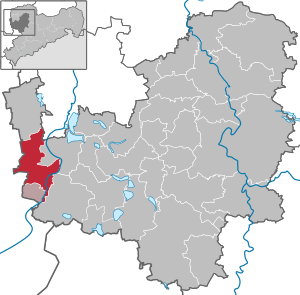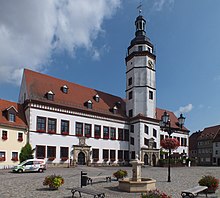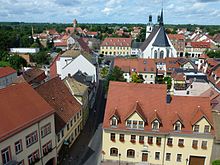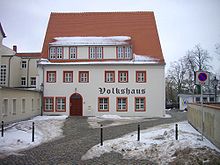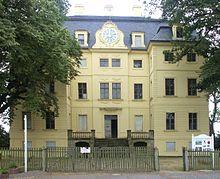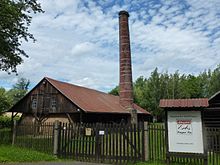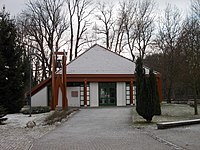Pegau
| coat of arms | Germany map | |
|---|---|---|

|
Coordinates: 51 ° 10 ′ N , 12 ° 15 ′ E |
|
| Basic data | ||
| State : | Saxony | |
| County : | Leipzig | |
| Management Community : | Pegau | |
| Height : | 127 m above sea level NHN | |
| Area : | 48.8 km 2 | |
| Residents: | 6325 (Dec. 31, 2019) | |
| Population density : | 130 inhabitants per km 2 | |
| Postal code : | 04523 | |
| Area code : | 034296 | |
| License plate : | L , BNA, GHA, GRM, MTL, WUR | |
| Community key : | 14 7 29 350 | |
| LOCODE : | DE PEA | |
| City structure: | 19 districts | |
City administration address : |
Markt 1 04523 Pegau |
|
| Website : | ||
| Mayor : | Frank Rösel (independent) | |
| Location of the city of Pegau in the Leipzig district | ||
Pegau is a small town in the district of Leipzig , Free State of Saxony in Germany . It is the seat of the Pegau administrative community .
geography
Geographical location
Pegau is about 25 km south of Leipzig on the White Elster and borders with its northeastern districts on the Zwenkauer See. The Profener Elstermühlgraben flows through the city in the fertile Leipzig lowland bay , not far from the border with Saxony-Anhalt . Due to the direct location on the federal highway 2 and the proximity of the A 38 (exit Leipzig-Südwest 13 km away) Pegau is very easy to reach. Pegau has a rail link and is connected to Berlin and Munich by the Leipzig-Gera railway line . The city center of Leipzig and the Leipzig / Halle Airport in Schkeuditz can be reached in 30–45 minutes by car. It is about 25 minutes by train to Leipzig Central Station . The Elster Cycle Path and the Neuseenland Cycle Route make Pegau accessible to bicycle tourism, and through the White Elster from Zeitz to Leipzig, also to water tourism.
Neighboring municipalities
| Lützen | Markranstädt | Knautnaundorf ( Leipzig ) |
| Hohenmölsen |

|
Zwenkau |
|
Elstertrebnitz Profen ( Elsteraue ) |
Groitzsch |
The neighboring towns of Pegau are directly adjacent to the Leipzig district of Knautnaundorf , Zwenkau , Groitzsch , Elstertrebnitz , Markranstädt , Lützen and Hohenmölsen . A little further away are the cities of Zeitz in the south, Weißenfels in the west and Borna in the east.
Districts
With the incorporation of Wiederaus on January 1, 1994, the city initially consisted of seven and from January 1, 2012, with the addition of Kitzens, of nineteen districts. If districts that have been incorporated several times are not taken into account, other figures may result.
From 1973 the community of Wiederau included the previously self-administered localities Großstorkwitz and Weideroda. Before that, Zauschwitz joined the community of Weideroda in 1934. Maschwitz was parish off to Großstorkwitz as early as 1548 and, according to sources, was never an independent parish in terms of state politics.
Kitzen grew around the towns of Eisdorf, Sittel and Thesau in 1950, after Hohenlohe was incorporated between 1925 and 1939. From 1947 Peißen and from 1950 Löben, Seegel and Werben, which went with Scheidens to Kitzen in 1994, belonged to Scheidens. Groß- and Kleinschkorlopp were merged with an administrative reform of 1950 to form Schkorlopp, which also became part of Kitzens in 1994.
As early as 1934 Carsdorf and in 1965 the corridor of the devastated village of Stöntzsch was incorporated into the city of Pegau.
| District | Year of incorporation |
from 1960 | before 1960 |
|---|---|---|---|
| previous incorporations | |||
| Carsdorf | 1934 | ||
| ( Stöntzscher corridor) | 1965 | ||
| Again | 1994 | ||
| Großstorkwitz | 1994 | from 1973 to Wiederau | |
| Maschwitz | 1994 | before 1934 to Großstorkwitz | |
| Weideroda | 1994 | ||
| Zauschwitz | 1994 | from 1934 to Weideroda | |
| Fawns | 2012 | ||
| Hohenlohe | 2012 | from 193? to fawns | |
| Ice village | 2012 | from 1950 to Kitzen | |
| Thesau | 2012 | ||
| Sittel | 2012 | ||
| Parting | 2012 | from 1994 to Kitzen | |
| Piss | 2012 | from 1947 to Scheidens | |
| Praise | 2012 | from 1950 to Scheidens | |
| Sea sail | 2012 | ||
| Advertise | 2012 | ||
| (Schkorlopp) | 2012 | ||
| Grand Schkorlopp | 2012 | from 1950 to Schkorlopp | |
| Kleinschkorlopp | 2012 | ||
history
Pegau was first mentioned in a document in 1096 in connection with the founding of the Pegau monastery by Wiprecht von Groitzsch . The cenotaph of Margrave Wiprecht von Groitzsch, the deceased adversary of Pope Gregory VII in 1124 , is in the Pegau Church. In 1155, a monk from the Pegau monastery wrote “Annales Pegaviensis”, the Pegau Annals, an important medieval historiography.
Pegau was persecuted by witches from 1604 to 1605 . One person got into a witch trial .
In 1740 the Prussian King Friedrich the Great made a guest appearance in Pegau. Emperor Napoleon , Tsar Alexander I and the Emperor of Austria Franz I stayed in Pegau in 1813.
- Population development

The increase in population from 4546 to 6365 inhabitants in 2012 is due to the incorporation of Kitzens.
politics
City council
Since the municipal council election on May 26, 2019 , the 18 seats of the city council have been distributed among the individual groups as follows:
- Per Pegau (PP): 7 seats
- CDU : 3 seats
- Free electoral association Kitzen (FWK): 3 seats
- Citizens for Kitzen with districts (BfK-mO): 3 seats
- AfD : 1 seat
- SPD : 1 seat
mayor
- since 1990–2015: Peter Bringer ( New Forum , now independent)
With the election of June 7, 2015, Frank Rösel (non-party) was elected as his successor, Peter Bringer no longer stood.
coat of arms
Description : In blue a red armored and red tongued golden lion .
Culture and sights
Saint Lawrence Church
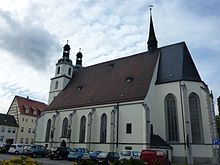
With the construction of the upper town, the Laurentiuskirche was built before 1190. In 1382 the town and with it the Laurentiuskirche and the Church of St. Otto in the lower town fell victim to a town fire. Of the former Romanesque church, only parts of the westwork survived the fire and were incorporated into the new building. The raids of the Hussites 1419–1434, the Saxon fratricidal war 1446–1451 and the plague epidemics delayed construction progress. The reconstruction took over 80 years.
In the church is the cenotaph of Margrave Wiprecht von Groitzsch, founder of the Sankt Jakob monastery in Pegau, which was consecrated in 1096 . The cenotaph bears one of the most important Romanesque sculptures in the Saxon art space. It was created by an unknown artist around 1230 (ie around 20 years before the Naumburg donors ), around a hundred years after Wiprecht's death, probably on behalf of Abbot Siegfried von Reckkin.
On the south side of the Laurentiuskirche is directly opposite the Protestant rectory, which u. a. Parish office and cemetery administration houses.
town hall
The town hall is located in the middle of the city and shapes the old cityscape. It was built from 1559 to 1561 by Paul Widemann and Hieronymus Lotter in the forms of the German Renaissance. The great resemblance to Leipzig's Old Town Hall (built in 1556/57), which Lotter and Widemann had previously worked on, is striking . The town hall tower can be climbed in the summer months. At a height of 30 meters, a panoramic view of Leipzig to the Monument to the Battle of the Nations is possible. The town hall is the seat of the city administration and has a large hall that is used for youth consecrations, graduation ceremonies and other celebrations.
Museum of the City of Pegau
The Pegau Museum can be reached via the entrance to the town hall tower. There are some unique exhibits from the near and distant past.
Post mile pillars
A replica of the Kursächsische Postmeile Pillar , which was made in 1723 and set up in front of the Leipziger Tor , stands today on the Elsterbrücke. The original piece of coat of arms is weathered beyond recognition in a grove. The artist Erika Zuchold used the original block of letters stored in the Erbs brickworks for a work of art in the city of Pegau in 2010 . A second post mile pillar was erected in front of the Obertor in 1723 , demolished in 1875, sold and used for a war memorial in Profen .
Old post

This building, which was built by Martin Schirmer (1611–1661) in 1655/56, housed the administration of the Pegau Office until 1661. In the second third of the 19th century, Gustav Ferdinand Grimmer (1803–1855), one of the city's most important citizens, owned this property. Grimmer was the founder of an agricultural association, the trade association, he set up a children's institution and a sewing and knitting school and campaigned for the connection of Pegau to the emerging railway network. Grimmer was the first to establish the cigar making trade in Saxony. The Pegau Post Expedition was located here from 1868 to 1880. The "arcade" located on a farm building in the courtyard is one of the last remaining monuments of its kind in the city. Also unique in Pegau is the preserved coffered stucco ceiling on the ground floor and the ceiling painting from the Renaissance in the gate passage.
Napoleon's house
The Pegau town hall was located here until 1561. The current building was built in 1744. As the most elegant house in the city, after the battle of Grossgörschen Emperor Napoleon I on May 3, 1813 and before the Battle of Leipzig on October 15, 1813, the Russian Tsar Alexander I used it as night quarters. The Napoleon House was auctioned by the city as the only bidder in 2005 to renovate and operate it. At the end of 2012, the city library moved into the first floor, on the ground floor there is a Diakonie counseling center and a training room for the Leipziger Land adult education center.
Volkshaus
The building, built in 1553/54, housed the Pegau boys 'school until 1835 and then the girls' school until 1869. Then it was converted into a restaurant. In 1990 it was closed. The house was built with the support of the “Volkshaus Pegau” e. V. completely renovated and released for use on October 3, 2004. The Volkshaus has a large and a small hall in which up to 15 large events and numerous small events and festivals are held every year. In addition, there are regularly five to six events per low and high season of the Pegau Carnival Club (PKK).
Melanchthon pear tree
According to the story, delicious pears ripened in a parish garden in Saxony 450 years ago, cherished and tended by the pastor. He gave his fruit to Philipp Melanchthon, who was visiting . The reformer found the fruits so tasty that he took some of them and later offered them to the elector. Delighted by the delicious fruit, the prince generously rewarded the pear-growing pastor. He planted more pears and thankfully named them Melanchthon pears.
Since March 21, 2010, a pear tree of the Roman Lard Pear variety has been planted again as a gift from the von Ribbeck family from Havelland . This is an old pear variety that survived the so-called Little Ice Age in the 17th century and is immortalized in the ballad Herr von Ribbeck auf Ribbeck in the Havelland by Theodor Fontane .
Castle residence and former district court

After the secularization of the Pegau monastery , parts of the remaining building fabric were used for profane purposes. After the Thirty Years' War , the former Electoral Saxon office on Kirchplatz was relocated here. When the Pegau office was sold to Duke Moritz von Sachsen-Zeitz in 1662 , he and later his son Moritz Wilhelm used part of the building as a summer residence until the Zeitz secondary school expired in 1718 (hence the name Schlossplatz). In 1909 the old office building was demolished and the new local court building, completed in 1912, was built by the Pegau master builder Julius Patzschke, with a prison building that was bombed in World War II . After 1949 there were children's and health facilities (crèche, kindergarten and rural outpatient clinic) here. In 1998 it was converted into a facility for assisted living ("castle residence").
Castle Wiederau
The baroque palace Wiederau is one of the most important examples of baroque architecture in Saxony and the only surviving representative of the representative Dresden palace type of this time. It was built by council builder Gregor Fuchs in 1705 on the site of a medieval moated castle. The client was the Leipzig trader David Fleischer . In 1703 he was ennobled and named himself after his ancestors von Fletscher. After Fletscher's death in 1716, his heirs kept the estate until 1728. In 1737 the Saxon Conference Minister Johann Christian von Hennicke acquired it after it had changed hands twice. On the occasion of a tribute to the subjects, Johann Sebastian Bach's cantata “Pleasant Wiederau, rejoice in your floodplains” was written in 1737 and made the palace an important point of reference in music history. After 1945, there was space in the castle for displaced persons, the municipal administration, a doctor's practice and a day-care center. Despite adverse circumstances (shortage of materials), committed citizens saved it from total ruin before it was extensively renovated in 1996/97. It is worth mentioning the illusionistic ceiling painting in the ballroom, which is unique in the Free State and extends over two floors of the three-story building. The wall and ceiling paintings are by the Italian painter Giovanni Francesco Marchini . In 2010 the castle was sold. Every year on the day of the open monument , you can explore the castle from the inside on guided tours. Concerts and baroque festivals take place around the castle at regular intervals. a. organized by the castle association.
Water tower
The water tower from 1906 stands near the station. The year is written above the entrance. His architect Otto Enke gave him the shape of the Vestnerturm, part of the castle in his hometown Nuremberg . He also designed the spire with the golden dome at the Russian Memorial Church in Leipzig . In Pegau, execution and design are based entirely on the style of the Wilhelminian era. The task of the water tower is to use an elevated tank to absorb the fluctuating water consumption and to ensure a constant supply pressure. The elevated tank has a capacity of 350 cubic meters. In 1995/96 the building was thoroughly renovated.
Brickyard Erbs
The Erbs brickworks technical monument is ideal for those interested to get to know the extraction of building materials 100 years ago. Storks have been nesting on the brickworks forge since 1988.
More Attractions
Other sights include the defense towers of the remaining city wall, the city library in the Alte Wache, the imperial post office and the post office portal, the blacksmith's shop in Wiederau, a miracle fountain in the Seegel district, and the King Albert Hain on both banks of the White Elster to the east the federal road 2.
In addition to the already mentioned St. Laurentius Church and the Protestant rectory in the center of Pegau, there is also the St. John's Church in the cemetery and, since 1996, the St. Hedwig Catholic Chapel opposite the city library. In the parts of the community, the St. Leonardikirche in Großstorkwitz, the Baroque church in Wiederau, the St. Georgskirche in Eisdorf and the Kreuzkirche Kitzen are worth a visit.
The St. Mauritius Church existed on Stöntzscher Flur until 1964, and has been accessible again since 2011 thanks to a memorial site set up by the Pegau parish.
Memories of the Lützow Freikorps can be found in Kitzen and the surrounding area .
Sports
The TuS Pegau is a Pegauer football club, the German in 1931 vice-champion of the Workers Gymnastics and Sports Federation was. There is also the VC 68 Pegau (volleyball club) and the SV 2000 Pegau (bowling club).
Economy and Infrastructure
Educational institutions
- " Frédéric Joliot-Curie " primary school
- "Frédéric Joliot-Curie" high school
industrial Estate
Companies from the following sectors have settled in the industrial area: steel construction, tool construction, precast concrete construction , PVC injection molding production, vehicle and body construction, building materials trade, lighting construction, special cleaning manufacturers, detergent production, production of sanitary installations, petrol stations and fuels.
traffic
The station Pegau is located at the Leipzig-Probstzella railway and formerly of the railway line Neukieritzsch-Pegau .
Personalities

sons and daughters of the town
Personalities who worked in Pegau
- Wiprecht von Groitzsch (around 1050–1124), Margrave of the Ostmark, (Lower) Lusatia and the Margraviate of Meißen, died in Pegau
- Paul Widemann († 1568), a. a. Master builder of the Pegau town hall
- Hieronymus Lotter (1497–1580), built the Leipzig City Hall and provided the construction plans for the Pegau City Hall
- Maximilian Mörlin (1516–1584), Protestant theologian and reformer, pastor from 1539
- Salomon Deyling (1677–1755), Protestant theologian, from 1709 pastor and superintendent in Pegau
- Katharina Landgraf (* 1954), politician, lives in the Großstorkwitz district
literature
- Hanns Becker: About food, clothing, accommodation and drinking water supply in the city of Pegau in the past. in: Sächsische Heimatblätter Heft 3/1957, pp. 255–261
- Gabriele Katz: 100 years of Westphal in Pegau. A regional story . Pegau 2000
- A. Kühn: Contributions to the local history of Pegau . Pegau 1895
- Dietrich Zühlke: Pegau - sketch of the structure of a city and its surroundings in the 19th century . in: Sächsische Heimatblätter issue 1/1963, pp. 49–61
- An extensive tradition of the city of Pegau for the period 1285-1945 on imperial, constitutional and community matters, loan letters, privileges, concessions, finances, military and war matters, health and social services, trade, trade, industry, agriculture, regulatory and Security police, fire protection, statistics, elections, school, church, building management, traffic and the city court are located in the Saxon State Archives, State Archives Leipzig, stock 20619 City of Pegau.
Web links
- Pegau in the Digital Historical Directory of Saxony
- Pegau Annals
Individual evidence
- ↑ Population of the Free State of Saxony by municipalities on December 31, 2019 ( help on this ).
- ^ Maschwitz in the Digital Historical Directory of Saxony
- ↑ Alphabetical index of the municipalities in Germany 1900. Archived from the original on February 2, 2017 ; accessed on August 29, 2017 .
- ↑ a b Incorporation of Hohenlohe to Kitzen between 1925–1939, exact year unknown.
- ↑ Community association of large and small corpses until 1994
- ↑ Manfred Wilde : The sorcery and witch trials in Kursachsen , Cologne, Weimar, Vienna 2003, p. 555f.
- ↑ State Statistical Office of the Free State of Saxony
- ↑ Results of the 2019 municipal council elections
- ^ Parish of Pegau
- ↑ St. Mauritius Church Stöntzsch (+1964). Retrieved August 27, 2017 .
- ↑ 20619 City of Pegau. In: State Archives Leipzig. Retrieved March 27, 2020 . (Info text under "Introduction")

